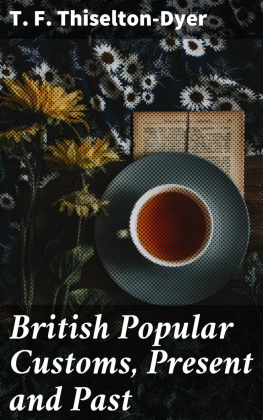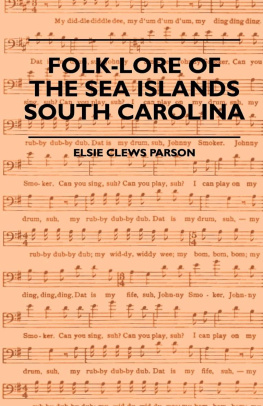T. F. (Thomas Firminger) Thiselton-Dyer - Domestic folk-lore
Here you can read online T. F. (Thomas Firminger) Thiselton-Dyer - Domestic folk-lore full text of the book (entire story) in english for free. Download pdf and epub, get meaning, cover and reviews about this ebook. year: 1881, publisher: Cassell, Petter, Galpin, genre: Romance novel. Description of the work, (preface) as well as reviews are available. Best literature library LitArk.com created for fans of good reading and offers a wide selection of genres:
Romance novel
Science fiction
Adventure
Detective
Science
History
Home and family
Prose
Art
Politics
Computer
Non-fiction
Religion
Business
Children
Humor
Choose a favorite category and find really read worthwhile books. Enjoy immersion in the world of imagination, feel the emotions of the characters or learn something new for yourself, make an fascinating discovery.

- Book:Domestic folk-lore
- Author:
- Publisher:Cassell, Petter, Galpin
- Genre:
- Year:1881
- Rating:5 / 5
- Favourites:Add to favourites
- Your mark:
- 100
- 1
- 2
- 3
- 4
- 5
Domestic folk-lore: summary, description and annotation
We offer to read an annotation, description, summary or preface (depends on what the author of the book "Domestic folk-lore" wrote himself). If you haven't found the necessary information about the book — write in the comments, we will try to find it.
Domestic folk-lore — read online for free the complete book (whole text) full work
Below is the text of the book, divided by pages. System saving the place of the last page read, allows you to conveniently read the book "Domestic folk-lore" online for free, without having to search again every time where you left off. Put a bookmark, and you can go to the page where you finished reading at any time.
Font size:
Interval:
Bookmark:

Author of "British Popular Customs" and "English Folk-lore."
LONDON, PARIS & NEW YORK.
| CHAPTER I. BIRTH AND INFANCY. | |
| Value of SuperstitionsLucky Days and Hours of BirthThe CaulThe ChangelingThe Evil Eye"Up and not Down"Rocking the Empty CradleTeeth, Nails, and HandsThe Maple and the AshUnchristened Children | 1 |
| CHAPTER II. CHILDHOOD. | |
| Nursery LiteratureThe Power of BaptismConfirmationPopular PrayersWeather RhymesSchool SuperstitionsBarring out | 16 |
| CHAPTER III. LOVE AND COURTSHIP. | |
| Love-testsPlants used in Love-charmsThe Lady-birdThe SnailSt. Valentine's DayMidsummer EveHallowe'enOmens on Friday | 23 |
| CHAPTER IV. MARRIAGE. | |
| Seasons and Days propitious to MarriageSuperstitions connected with the BrideMeeting a FuneralRobbing the Bride of PinsDancing in a Hog's TroughThe Wedding-cakeThe Ring | 36 |
| CHAPTER V. DEATH AND BURIAL. | |
| Warnings of DeathThe Howling of DogsA Cow in the GardenDeath-presaging BirdsPlantsThe Will-o'-the-WispThe Sympathy between Two PersonalitiesProphecyDying HardlyThe Last ActPlace and Position of the Grave | 48 |
| CHAPTER VI. THE HUMAN BODY. | |
| Superstitions about Deformity, Moles, &c.Tingling of the EarThe NoseThe EyeThe TeethThe HairThe HandDead Man's HandThe Feet | 65 |
| CHAPTER VII. ARTICLES OF DRESS. | |
| New Clothes at Easter and WhitsuntideWearing of ClothesThe Clothes of the DeadThe Apron, Stockings, Garters, &c.The ShoeThe GloveThe RingPins | 81 |
| CHAPTER VIII. TABLE SUPERSTITIONS. | |
| Thirteen at TableSalt-spillingThe KnifeBread, and other Articles of FoodWishing BonesTea-leavesSinging before BreakfastShaking Hands across the Table | 100 |
| CHAPTER IX. FURNITURE OMENS. | |
| Folk-lore of the Looking-glassLuck of EdenhallClock-fallingChairsBedsThe Bellows | 111 |
| CHAPTER X. HOUSEHOLD SUPERSTITIONS. | |
| Prevalence and Continuity of SuperstitionsSneezingStumblingA Whistling WomanSweepingBreaking CrockeryFires and CandlesMoneyOther Superstitions | 120 |
| CHAPTER XI. POPULAR DIVINATIONS. | |
| Bible and KeyDippingSieve and ShearsCrowing of the CockSpatulamanciaPalmistry and OnymancyLook-divinationAstrologyCardsCasting LotTea-stalks | 134 |
| CHAPTER XII. COMMON AILMENTS. | |
| Charm-remediesFor AgueBleeding of the NoseBurnsCrampEpilepsyFitsGoutHeadache, &c. | 148 |
| CHAPTER XIII. MISCELLANEOUS HOUSEHOLD LORE. | |
| Horse-shoesPrecautions against WitchcraftThe CharmerSecond SightGhostsDreamsNightmare | 169 |
| 181 |
BIRTH AND INFANCY.
Font size:
Interval:
Bookmark:
Similar books «Domestic folk-lore»
Look at similar books to Domestic folk-lore. We have selected literature similar in name and meaning in the hope of providing readers with more options to find new, interesting, not yet read works.
Discussion, reviews of the book Domestic folk-lore and just readers' own opinions. Leave your comments, write what you think about the work, its meaning or the main characters. Specify what exactly you liked and what you didn't like, and why you think so.




